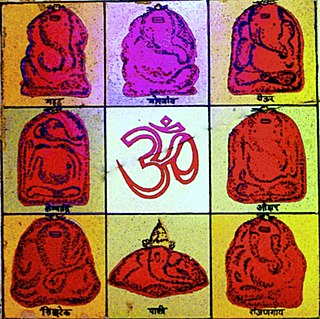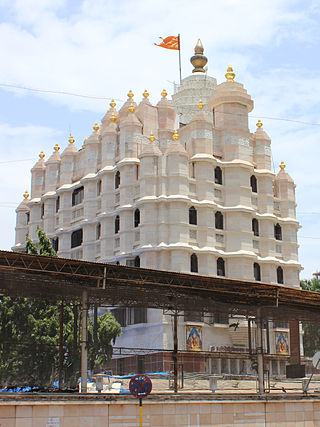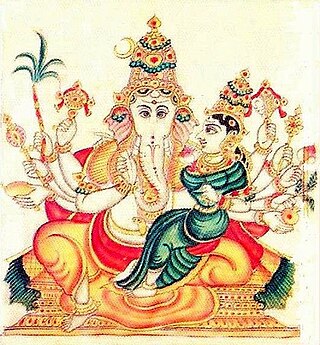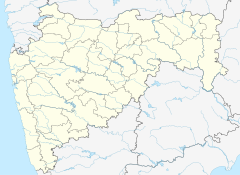
Ashtavinayaka is a Sanskrit term which means "eight Ganeshas". The Ashtavinayaka Yatra refers to a pilgrimage to the eight Hindu temples in the state of Maharashtra, India, centered around the city of Pune. The eight temples house eight distinct idols of Ganesha, the Hindu deity of unity, prosperity, learning, and removing obstacles. Each of these temples has its own individual legend and history, as distinct from each other as the murtis in each temple. The form of each murti of Ganesha and his trunk are distinct from one another. There are other temples of eight Ganesha in various other parts of Maharashtra; however, the ones around Pune are more well known and visited. It is believed that to complete the Ashtavinayaka Yatra, one must revisit the first temple after visiting all the eight temples.

Uthamar Kovil in Uthamarkoil, a village in the outskirts of Tiruchirappalli in the South Indian state of Tamil Nadu, is dedicated to the Hindu Trimurti of Vishnu, Shiva, and Brahma. Constructed in the Dravidian style of architecture, the temple is glorified in the Nalayira Divya Prabandham, the early medieval Tamil canon of the Alvar saints from the 6th–9th centuries CE. It is one of the 108 Divya Desams dedicated to Vishnu, who is worshipped as Purushothaman Perumal and his consort Lakshmi as Poornavalli Thayar.

Lenyadri, sometimes called Ganesa Lena, Ganesh Pahar Caves, are a series of about 30 rock-cut Buddhist caves, located about 4.8 kilometres (3.0 mi) north of Junnar in Pune district in the Indian state of Maharashtra. Other caves surrounding the city of Junnar are: Manmodi Caves, Shivneri Caves and Tulja Caves. The Lenyadri caves date between the 1st and 3rd century AD and belong to the Hinayana Buddhism tradition.

Varadvinayak, also spelt as Varadavinayaka, is one of the Ashtavinayak temples of the Hindu deity Ganesha. It is located in Mhad village situated in Khalapur taluka near Karjat and Khopoli of Raigad District, Maharashtra, India. The temple was built (restored) by Peshwa General Ramji Mahadev Biwalkar in 1725AD.

The Shri Siddhivinayak Ganapati Mandir is a Hindu temple dedicated to Ganesha. It is located in Prabhadevi neighbourhood of Mumbai, Maharashtra, India. It was originally built by Laxman Vithu and Deubai Patil on 19 November 1801. It is one of the most popular Hindu temples in Mumbai.

Ganapatya is a denomination of Hinduism that worships Ganesha as the Saguna Brahman.

Karpaka Vinayaka Temple or Pillaiyarpatti Pillaiyar Temple is a 7th-century CE rock-cut cave shrine, significantly expanded over the later centuries. It is located in Pillayarpatti village in Tiruppathur Taluk, Sivaganga district in Tamil Nadu, India.

Arulmigu Murugan Temple, Thiruparankundram is a Tamil temple dedicated to the god Murugan at Thiruparankundram, Tamilnadu, India. It is regarded as one of the "six Abodes of Murugan". The temple is built in rock-cut architecture and believed to have been built by the Pandyas during the 6th century. According to the legend. it is where Murugan slayed the demon Surapadman and married Devasena also known as Deivayanai, the daughter of the king of heavens, Indra. Also, Murugan is said to have worshipped his father Shiva here as Parangirinathar.

Ganesha, also spelled Ganesh, and also known as Ganapati, Vinayaka, and Pillaiyar, is one of the best-known and most worshipped deities in the Hindu pantheon and is the Supreme God in the Ganapatya sect. His depictions are found throughout India. Hindu denominations worship him regardless of affiliations. Devotion to Ganesha is widely diffused and extends to Jains and Buddhists and beyond India.

Siddhatek is a town in the Ahmednagar district of the western part of India located on the Bhima River. The town is known for its temple to Sri Siddhi Vināyaka, the right-tusked incarnation of Ganesha as "Masterful Remover". Legends surrounding the north-facing temple suggest it was built to commemorate the place where Lord Vishnu defeated the evil Asuras Madhu-Kaitabh with the blessing of Siddhi Vināyaka. The shrine is particularly popular during the festivals of Ganesh Jayanti, Vijayadashami and Somvati Amavasya.

Ganesh Jayanti (literally "Ganesha's birthday", also known as Magha shukla chaturthi, Tilkund chaturthi, and Varad chaturthi, is a Hindu festival. This occasion celebrates the birth day of Ganesha, the lord of wisdom. It is a popular festival particularly in the Indian state of Maharashtra and it is also celebrated in Goa held during the shukla paksha chaturthi day in the month of Magha as per the Hindu calendar, which corresponds to the Gregorian calendar month of January/February. In 2022, Ganesh Jayanti falls on 4 February.

Shri Mayureshwar Mandir or Shri Moreshwar Temple is a Hindu temple (mandir) dedicated to Ganesha, god of wisdom. It is located in Moragaon in Pune District, about 65 km away from Pune city in the Indian state of Maharashtra. The temple is the starting and ending point of a pilgrimage of eight revered Ganesha temples called Ashtavinayaka.

Sri Bhramaramba Mallikarjuna Temple or Srisailam Temple is a Hindu temple dedicated to the deities Shiva and Parvati, located at Srisailam in the Indian state of Andhra Pradesh.

The Chintamani Temple of Theur is a Hindu temple dedicated to Supreme God Ganesha according to Ganapatya Sect located 25 km (16 mi) from Pune, the temple is "one of the larger and more famous" of the Ashtavinayaka, the eight revered shrines of Ganesha in the Indian state of Maharashtra.

The Vigneshwara Temple or Vighnahar Ganapati Temple of Ozar is a Hindu temple dedicated to Ganesha, the elephant-headed god of wisdom. The temple is one of the Ashtavinayaka, the eight revered shrines of Ganesha in Maharashtra, India. The Ganesha form worshipped here is called Vigneshwara or Vignahar and is associated with the legend of Ganesha defeating Vignasura, the demon of obstacles.

Pallikondeswara Temple(also Pradosha kshetram) is a Hindu temple dedicated to the god Shiva located in Surutupalle, a village in Tirupati district of Andhra Pradesh, India. The presiding deity Pallikondeswara, unlike other Shiva temples, is sported in reclining posture lying on the lap of his consort Parvati.

Vinayaki (Vināyakī) is an elephant-headed Hindu goddess. Her mythology and iconography are not clearly defined. Little is told about her in Hindu scriptures and very few images of this deity exist.

Mahaganapati, literally "Ganesha, the Great"), also spelled as Maha Ganapati, and frequently called Mahaganadhipati, is an aspect of the Hindu god Ganesha. He is the representation of Ganesha as the Supreme Being Paramatman and is the most important deity of the Ganesha-centric Ganapatya sect. He is one of the most popular of the thirty-two forms of Ganesha, worshipped as a representation of the ultimate truth Para brahman.
Tharakaparamesvarar Temple is a Hindu temple dedicated to the deity Shiva, located at Kondal in Nagapattinam district in Tamil Nadu, India.
Mallikarjunar Temple is a Hindu temple dedicated to the deity Shiva, located at Dharmapuri in Dharmapuri district in Tamil Nadu, India.






















